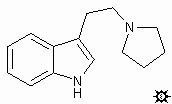
#52. PYR-T
TRYPTAMINE, N,N-TETRAMETHYLENE; INDOLE, 3-[2-(1-PYRROLIDYL)ETHYL]; PYRROLIDINE, 1-[2-(3-INDOLYL)ETHYL]; N,N-TETRAMETHYLENETRYPTAMINE; 1-[2-(1H-INDOL-3-YL)ETHYL]PYRROLIDINE; 1-[2-(1-PYRROLIDYL)ETHYL]INDOLE; "PYRROLIDYLTRYPTAMINE"

|
| [3D .mol structure] |
A solution of 0.76 g indol-3-yl-N,N-tetramethyleneglyoxylamide in 15 mL anhydrous dioxane was added, slowly, to 0.8 g LAH in 15 mL dioxane which was well-stirred and held at reflux temperature under an inert atmosphere. After the addition was complete, reflux was maintained for an additional 16 h, the reaction mixture cooled, and the excess hydride destroyed by the cautious addition of wet dioxane. The formed solids were removed by filtration, washed with hot dioxane, the filtrate and washings combined, dried over anhydrous MgSO4, and the solvent removed under vacuum. The residue was distilled at the KugelRohr at 0.05 mm/Hg yielding a fraction boiling at 170-180 °C which spontaneously crystallized. Thus, there was obtained 0.35 g (52%) of N,N-Tetramethylenetryptamine with a mp 114-115. IR (cm-1): 740, 784, 807, 886, 1011, 1108. MS (in m/z): C5H10N+ 84 (100%); indolemethylene+ 130 (7%); parent ion 214 (3%). A solution of this base in Et2O treated with anhydrous HCl gave the hydrochloride salt which, on recrystallization from MeOH/benzene, had a mp 193-194 °C.
DOSAGE : unknown
DURATION : unknown
QUALITATIVE COMMENTS : (with 25 mg, orally) "There was a general malaise without any particular spiritual or noble side to it. I was sick."
(with 50 mg, orally) "There is maybe something here, but it is unpleasant. Salivation, muscle and joint pains. I tried smoking it earlier and it was almost inactive. Certainly less potent than DMT or DET."
(with 70 mg, smoked) "This smells like a mixture of DMT and naphthalene. The effects began very soon and lead to an intense, but a little bit uncomfortable, high. I was distinctly dizzy, and the visuals were minor. I would classify this compound in the 'not too pleasant' category, certainly not colorful."
EXTENSIONS AND COMMENTARY : First of all, the name pyr-T, which is an abbreviation for "pyrrolidinyltrypamine" is out-and-out wrong. There is just one single nitrogen at the end of the tryptamine chain and it cannot be claimed by both halves of the name. It is intrinsic to the name pyrrolidine as well as to the name tryptamine. This is why the name is in quotation marks. This drug has occasionally been called PT in the popular literature, but the choosing to spell it out as pyr-T allows a parallel code to be used with the piperidine and morpholine analogues. These two analogues are both described in the literature. The piperidine material, pip-T, is made via the glyoxylamide (mp 182-183 °C) which is reduced with LAH to the target amine (mp 149-150 °C, HCl salt 220-221 °C). The morpholine analogue also came to be via the glyoxylamide (mp 187-188 °C) and the reduction to the amine which can be an oil, but which has been reported to have a mp 145-147 °C. The only trials I know of with either of these is with mor-T which, as the fumarate salt, had no effects at all upon the i.m. injection of a 30 milligram bolus.
Actually, this neat trilogy of heterocyclics, the pyrrolidine ring, the piperidine ring, and the morpholine ring, have been the chemists favorite for many years. Leaf through the "Known Tryptamines" appendix, and see how often you see stretched between the nitrogen substituents the phrases:
-- CCCC --
-- CCCCC --
-- CCOCC --
These are the exact rings. They are easy to make; they add a sense of sophistication to an otherwise pedestrian scientific paper; and they often represent the inactive extremes in a receptor site study of a structure activity relationship study of a CNS-active agent. But the compounds represented here appear to have simply the wrong properties, somehow, and should not really be seriously considered in the quest for understanding of the remarkable actions of most of the psychedelic phenethylamines and tryptamines.
And yet no observation, favorable or unfavorable, deserves to be discarded. The very failure to act in an expected way might, if completely understood, add to our intimate understanding of the mystery of why these materials do what they do.
| [ |
[Main Index] | [Forward |

